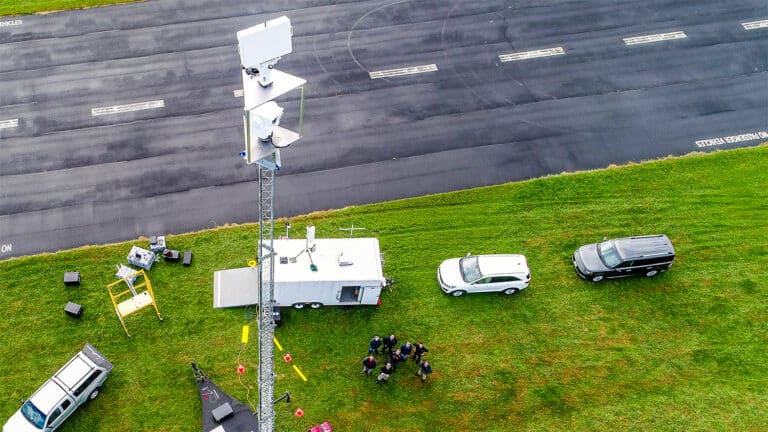Hong Kong Just Gave Drones Their Own Airwaves — and Left the FAA in the Dust

While the FAA drafts its 700‑page BVLOS rule, Hong Kong’s drones are already flying under their own spectrum.
Hong Kong’s Communications Authority has launched a dedicated frequency license specifically for drone communications, marking a significant infrastructure investment in the city’s rapidly expanding low-altitude economy. The 1430-1444 MHz band (1.4 GHz band) will provide an alternative to WiFi and cellular networks for establishing, maintaining, and operating drone radiocommunications installations.
The Unmanned Aircraft System (Private) Licence regime represents Hong Kong’s infrastructure-first approach to enabling routine drone operations at scale. By treating drone communications as essential telecommunications infrastructure rather than case-by-case aviation permits, the city is positioning itself to lead Asia-Pacific’s low-altitude economy development—a sector projected to reach $486 billion globally by 2035.
Dedicated Spectrum for Drone Operations
The Communications Authority spokesperson explained that the dedicated spectrum “offers an additional communications solution to UAS operators beyond the current use of wireless local area networks and 4G or 5G mobile network for data transmission and control, enhancing support for the safe and efficient operation of UAS and fully supporting the development of the LAE ecosystem in terms of communications networks.”
The frequency license is currently open only to organizations participating in Hong Kong’s Low Altitude Economy Regulatory Sandbox pilot projects. Applicants must submit information on their UAS operations, obtain approval from the Civil Aviation Department on specific flight paths, and provide details on radio base stations to be installed.
The Communications Authority stated it “will rigorously review the applications and closely monitor the use of the dedicated UAS spectrum to ensure compliance with license conditions and effective utilization of spectrum resources.”
Part of Broader Low-Altitude Economy Push
Hong Kong’s frequency license launch comes as part of the city’s ambitious Low-Altitude Economy Regulatory Sandbox, which officially kicked off on March 20, 2025. The government approved 38 pilot projects from 72 applications, covering emergency rescue, drone delivery, logistics distribution, infrastructure inspection, and surveillance applications.
Chief Executive John Lee emphasized that “the LAE is one of our nation’s strategic emerging industries, as well as the example in exploring new quality productive forces,” noting that the sector “not only gives rise to a series of industries, but also brings along a very wide scope of application scenarios with a tremendous potential for development.”
As of September 2025, 17 regulatory sandbox projects had commenced, with another 11 expected to launch by the end of October. Deputy Financial Secretary Michael Wong highlighted that the first phase of legislative amendments covering drones weighing 25kg to 150kg (55-330 lbs) has been completed, with more complex “Regulatory Sandbox X” pilot projects planned for cross-boundary routes and passenger-carrying aircraft.
Technical Standards and Requirements
Hong Kong’s Office of the Communications Authority published Type Approval Criteria TAC 013 in August 2025 specifically for radio equipment operating in the 1430-1444 MHz band for unmanned aircraft systems. This technical framework ensures that drone communication equipment meets performance and safety standards before deployment.
The dedicated spectrum allocation represents a significant departure from relying solely on consumer-grade WiFi or mobile networks, which can face interference and capacity constraints in dense urban environments like Hong Kong. The 1.4 GHz band provides more reliable line-of-sight communications for command and control functions, particularly important for beyond visual line of sight (BVLOS) operations over water and urban areas.
Global Context: Europe’s Regulatory Sandbox Approach
Europe is taking a similar regulatory sandbox approach to accelerate drone deployment, though without dedicated spectrum allocation. The U-ELCOME project, involving 51 partners across Spain, Italy, and France, aims to enable safe regular drone operations by 2025 and replicate the framework across Europe by 2026.
The project is conducting tests and demonstrations across 15 locations, working closely with the European Union Aviation Safety Agency (EASA) and national authorities to consolidate standardization and regulatory requirements. The European drone delivery market is projected to grow from $280 million (€259 million) in 2025 to $1.62 billion (€1.5 billion) by 2031, reflecting a 33.4% compound annual growth rate.
European authorities are establishing UAV-specific corridors and launching sandbox programs to gather operational data. The EU’s Drone Strategy 2.0 emphasizes integrating drones into smart city ecosystems with dedicated infrastructure including vertiports, charging stations, and air traffic management systems.
However, regulatory frameworks remain fragmented across member states despite EASA’s coordinating role. Industry stakeholders have called for expanding regulatory sandboxes, improving aircraft conspicuity standards, and accelerating development of detect-and-avoid systems to unlock broader commercial adoption.
Canada Enables Nationwide BVLOS Operations
Canada has taken the most aggressive regulatory approach among Western nations, implementing comprehensive rules that allow routine BVLOS operations without case-by-case approvals. Transport Canada’s updated regulations, effective April 1 and November 4, 2025, fundamentally reshape the country’s drone operating environment.
The new framework introduces Level 1 Complex Operations certification for lower-risk BVLOS flights, allowing qualified operators to conduct eligible operations as standard procedures rather than seeking Special Flight Operations Certificates for each mission. The regulations also expand the maximum drone weight allowance to 150 kilograms (330 lbs), supporting industrial and commercial applications previously requiring special permits.
Organizations conducting BVLOS operations must obtain a RPAS Operator Certificate (RPOC) demonstrating they have necessary policies and procedures in place. Pilots need advanced operations certification, at least 20 hours of ground school, and must pass flight reviews.
Canadian drone operator Volatus Aerospace announced in May 2025 that it received nationwide BVLOS authorities including nighttime operations, fixed-corridor medical drone deliveries, and operations in Northern Domestic Airspace. The company’s regulatory advancements enable automated drone-in-a-box solutions through accepted risk mitigation protocols.
Industry estimates project Canada’s drone delivery market will grow from $40 million currently to over $500 million within five years. Alberta is investing nearly $5 million in a provincial “Air Traffic Control for Drones” project with AIRmarket Inc., deploying traffic management infrastructure throughout the province to support up to 100,000 daily flights for wildfire response and other applications.
United States Finally Publishes BVLOS Rule
After years of delays, the Federal Aviation Administration published its long-awaited BVLOS Notice of Proposed Rulemaking on August 5, 2025. The 700-page proposal would enable routine BVLOS operations up to 400 feet (122 meters) above ground level for drones weighing up to 1,320 pounds (599 kg) including payload.
Transportation Secretary Sean Duffy announced the rule following President Donald Trump’s June 6, 2025 executive order titled “Unleashing American Drone Dominance,” which mandated publication of a final BVLOS rule by February 2026.
The proposed framework establishes two pathways: permits for lower-risk, limited-scale operations issued rapidly, and certificates for higher-risk, larger-scale, or more complex operations requiring robust safety management. The rule introduces Automated Data Service Providers (ADSPs) to support scalable operations by providing services for traffic deconfliction, conformance monitoring, and UAS Traffic Management.
Notable exclusions include operations over large open-air crowds like concerts or sporting events. The rule allows BVLOS flights over people in five categories based on population density, with increasing operational restrictions for more densely populated areas.
Four companies have already received BVLOS authorization under the existing waiver system: Wing (Google), Amazon, Zipline, and Flytrex.
Flytrex CEO Yariv Bash stated that the BVLOS approval “transforms our entire business model,” enabling the company to “monitor fleets of drones from centralized command centers rather than posting observers across delivery zones.”
However, the FAA’s approach remains fundamentally different from Hong Kong’s infrastructure-first model. The U.S. system still requires operators to obtain permits or certificates before conducting operations, whereas Hong Kong is building dedicated communications infrastructure to enable multiple operators simultaneously.
DroneXL’s Take
Hong Kong’s dedicated frequency license reveals a fundamental philosophical divide in how governments approach drone infrastructure development. While the FAA spent years perfecting 700 pages of regulations before enabling routine BVLOS, Hong Kong built the communications infrastructure first and is collecting real operational data from 38 live pilot projects.
We’ve documented this pattern repeatedly. Hong Kong’s MTR Corporation cut tunnel inspection times by two-thirds using automated drones operating within the regulatory sandbox. The city’s Hospital Authority is flying 7.4-mile BVLOS missions over water to deliver medical supplies to outlying islands—operations that would require months of FAA waiver applications in the United States.
The infrastructure-versus-permissions divide extends beyond Hong Kong. China’s broader low-altitude economy initiative is targeting $486 billion by 2035 with the government promising “minimal interference and improved support services.” The Civil Aviation Administration of China is expediting airworthiness certification while provinces like Shenzhen are establishing dedicated low-altitude corridors and traffic management systems.
Canada deserves credit for breaking from the Western regulatory mold. By enabling routine BVLOS operations without case-by-case approvals, Transport Canada is treating drones more like commercial aviation with standardized certifications rather than experimental aircraft requiring special permits. The results speak for themselves—Volatus Aerospace now operates nationwide BVLOS including nighttime missions, something impossible under the FAA’s current framework.
Europe’s regulatory sandbox approach shows promise, but fragmentation across member states remains a barrier. The U-ELCOME project demonstrates what’s possible when regulators commit to gathering real operational data before finalizing rules. However, the lack of dedicated communications infrastructure like Hong Kong’s frequency allocation means European operators still rely on congested WiFi and cellular networks.
The FAA’s August 2025 BVLOS NPRM represents progress after years of delays, but it’s still just a proposed rule with public comments due October 6, 2025 and final implementation potentially not until 2026 or later. Meanwhile, Hong Kong operators are already flying complex BVLOS missions using dedicated communications infrastructure purpose-built for drone operations.
The question isn’t whether Western regulators will eventually enable routine BVLOS—they will. The question is how much economic opportunity and technological leadership will shift to Asia-Pacific while North America and Europe perfect their regulations. When China showcased its low-altitude economy ambitions at the Shanghai Advanced Air Mobility Expo, it wasn’t just displaying drones—it was demonstrating an entire ecosystem of infrastructure, standards, and operational capabilities that took years of “test first, regulate based on data” experimentation to develop.
Hong Kong’s frequency license might seem like a minor technical detail—just another radio spectrum allocation. But it represents something more significant: a government treating drone operations as inevitable and building the infrastructure to support them at scale, rather than viewing each drone flight as an exception requiring special permission.
What do you think? Should Western regulators follow Hong Kong’s infrastructure-first approach, or is the slower, more cautious regulatory process necessary for public safety? Share your thoughts in the comments below.
Discover more from DroneXL.co
Subscribe to get the latest posts sent to your email.
Check out our Classic Line of T-Shirts, Polos, Hoodies and more in our new store today!

MAKE YOUR VOICE HEARD
Proposed legislation threatens your ability to use drones for fun, work, and safety. The Drone Advocacy Alliance is fighting to ensure your voice is heard in these critical policy discussions.Join us and tell your elected officials to protect your right to fly.
Get your Part 107 Certificate
Pass the Part 107 test and take to the skies with the Pilot Institute. We have helped thousands of people become airplane and commercial drone pilots. Our courses are designed by industry experts to help you pass FAA tests and achieve your dreams.

Copyright © DroneXL.co 2025. All rights reserved. The content, images, and intellectual property on this website are protected by copyright law. Reproduction or distribution of any material without prior written permission from DroneXL.co is strictly prohibited. For permissions and inquiries, please contact us first. DroneXL.co is a proud partner of the Drone Advocacy Alliance. Be sure to check out DroneXL's sister site, EVXL.co, for all the latest news on electric vehicles.
FTC: DroneXL.co is an Amazon Associate and uses affiliate links that can generate income from qualifying purchases. We do not sell, share, rent out, or spam your email.


















